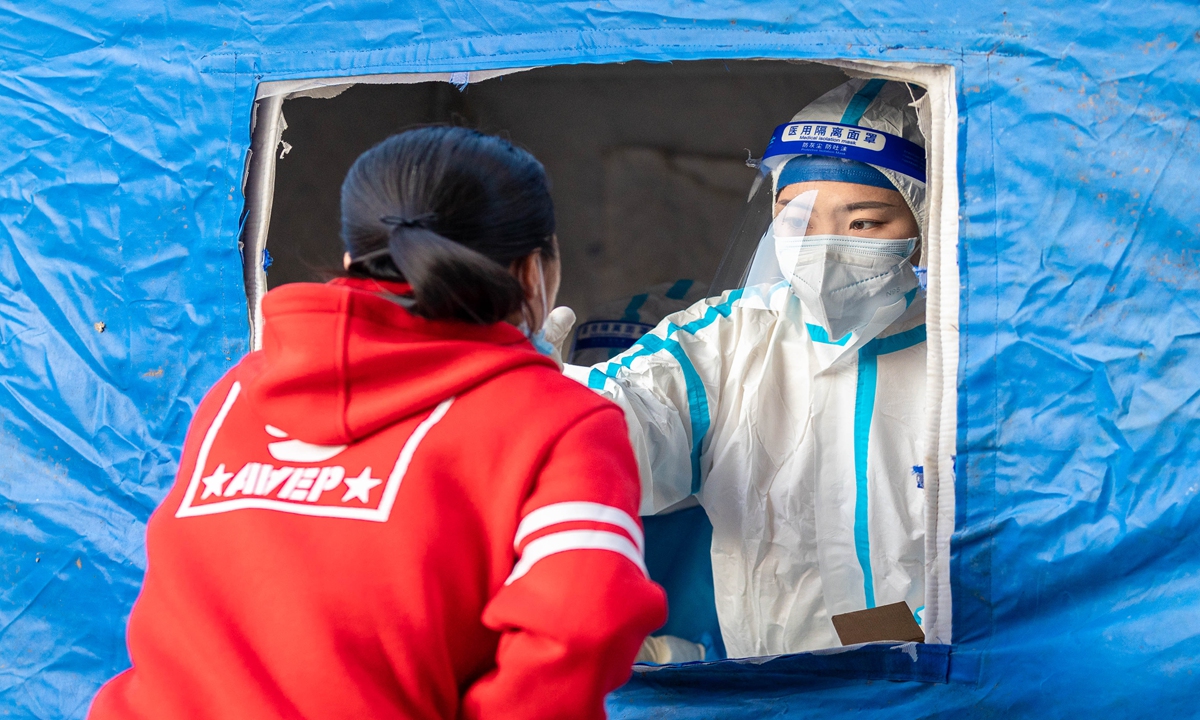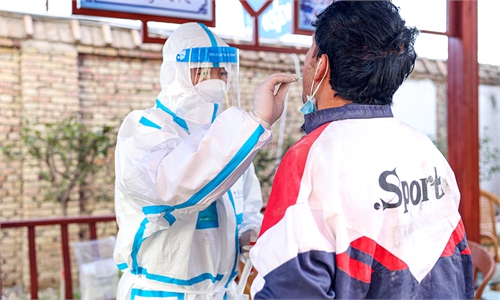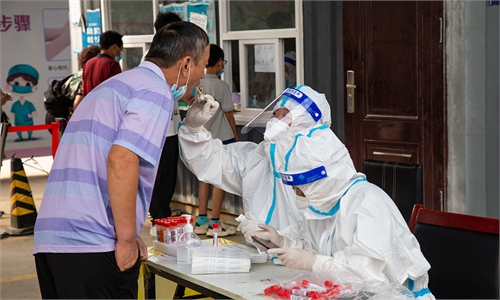Chinese cities tighten anti-epidemic measures amid holidays as new subvariant triggers regional resurgences

A resident receives nucleic acid testing in a residential community in Hohhot on Thursday. Photo: VCG
Chinese cities have tightened anti-epidemic measures including strengthening temperature and health checking at transportation stations, as well as making appointment before entering tourist attractions to avoid large personnel flow during the National Day holidays, to ensure a safe holiday, in the wake of flare-ups triggered by new Omicron subvariant BF.7.Several cities including Shanghai, Southwest China's Chongqing, East China's Nanjing and Urumqi in Northwest China's Xinjiang Uygur Autonomous Region have released requirements to residents who are going to return to cities or go back to work after the seven-day-long holidays.
On September 28, Hohhot in North China's Inner Mongolia Autonomous Region detected one local case. The Hohhot authorities said at a news briefing on October 1 that this round of outbreak was caused by Omicron subvariant BF.7 after gene sequencing. It's the first time that the new Omicron subvariant triggered a round of outbreak in Chinese mainland, according to media reports.
As of Thursday, Inner Mongolia Autonomous Region has reported 381 local confirmed cases including 346 in Hohhot and 1,554 asymptomatic carriers including 1,525 in Hohhot, said the local authorities on Friday.
Several areas in Inner Mongolia including the main urban area of Ulanhot will implement static management from Friday to Sunday and three rounds of mass nucleic acid testing, to curb the virus spreading.
As a subvariant of Omicron BA.5, BF.7 has enhanced immunity evasion compared with BA.5, which means that it's still possible that people could be infected with BF.7 even if they have been infected before or have taken COVID-19 vaccines, Zhuang Shilihe, a Guangzhou-based medical expert, told the Global Times on Friday.
The vaccines and oral antiviral pills used to treat COVID-19 are still effective toward BF.7, and the COVID-19 vaccines are effective at preventing severe cases and death from COVID-19, Zhuang noted. Residents are suggested to maintain good hygiene habits including wearing a facial mask and washing hands frequently.
Zhuang also noted that people should be precautious in face of the upcoming winter season which could face more pressure to curb the COVID-19 as well as the flu.
The Chinese mainland on Thursday reported 216 local confirmed COVID-19 cases and 1,267 asymptomatic carriers including 661 in Inner Mongolia, 96 in Xinjiang region and 56 in Central China's Hubei Province, according to the National Health Commission on Friday.
From October 1 to 5, Shanghai alone has reported 26 COVID-19 positive cases, who returned from other regions or were contacts of confirmed patients. The dominant variants were Omicron BA.5 and BA.2.76, which have faster transmission speed and a more latent characteristic, Wu Qianyu, a senior official with the Shanghai Health Commission, said at a press briefing on Thursday.
All personnel from other regions have to take nucleic acid tests after arriving at Shanghai within 24 hours and a seven-day self-health monitoring is required, according to Shanghai authorities.
Shanghai on Friday reported three new confirmed cases in communities, said the health authorities.
Northwest China's Shaanxi Province on Thursday reported 50 new cases, including 40 from the other regions.
A bus suspended services for violating the regulations on October 5 and left 40 passengers, who all had travel history in COVID-19 risky regions, in a highway service zone in Xianyang, Shaanxi. Local authorities said 19 of them were confirmed to be infected by COVID-19.
Tourist attractions have been making efforts to strengthen COVID-19 prevention measures to ensure tourists' safety as well as to build good images by trying their best.
Well-known tourist attraction Fenghuang old town in Central China's Hunan Province apologized on Friday and stated that they will provide one-year free entrance of all the A-level tourist attractions in the county in 2023 for those stranded tourists due to the epidemic.
Fenghuang county on Thursday announced to conduct a temporary static management after reporting four confirmed cases and one positive sampling in a mixed tube during a mass nucleic acid testing.
Also in Hunan's Zhangjiajie, another tourist attraction, some parts have conducted temporary static management since Thursday.
Haikou, South China's Hainan Province also on Thursday announced it is conducting a temporary static management from 7 am Thursday to 10 pm Friday. The city has reported seven cases since October 5, according to the authorities.


